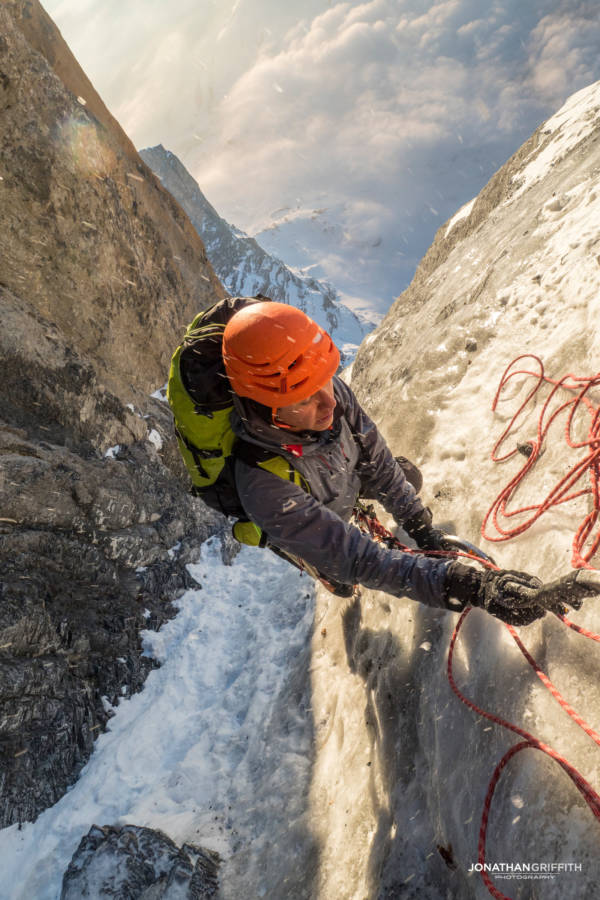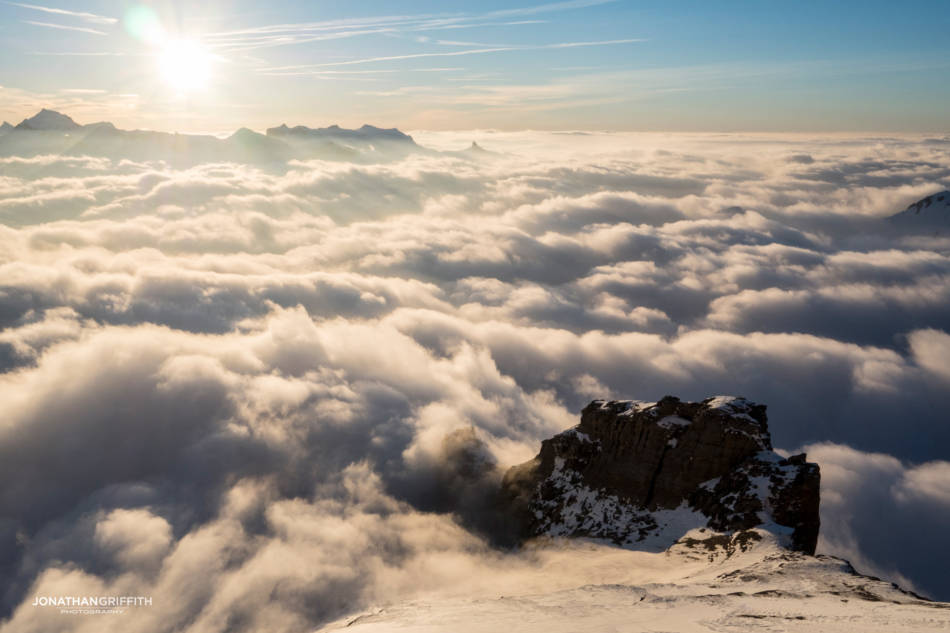
Eiger - 1938 Route North Face
When I was 20 I stepped down from the yellow La Poste bus on to a completely dark and deserted street in Grindelwald. I’d arrived at the famous home of the Eiger. I tried to scan the featureless sky above and ahead of me to try and make out even the faintest outlines of the mythical mountain but thoughts quickly turned to finding somewhere to bivy for the night. I spent a lot of time staring up at that wall from our camping spot tracing out all the stories I’d read over and over again in The White Spider. I watched storms roll in from nowhere and broil up in its huge concave face, I went for a walk underneath it and found a bit of climbing shrapnel and got lost in a world of fantasies as to the origin and its eventual demise coming tumbling down this face. But mainly I revelled in the history of it all and marvelled at what kind of a climber it would take to try such a monster. I think I was still under the illusion that it was only climbed a couple of times a year if that, and only by the world’s best. That was as close as I got to the face on my first visit - I had no intention of ever going near it and was busy still trying to come to grips with the basics of alpinism. The south side of the massifs were more my level.
A month later and it was time to pack up camp and move to the forests of Chamonix. I never left Grindelwald thinking I’d come back and climb the Nordwand, it was just way out of my league, and rereading the horrors in The White Spider with the face itself looming over you is enough to imprint those epic stories of alpinism deep in the brain.

The Eiger back in the day

Souvenir hunting under the face 13 years ago
I’m not sure whether the 1938 route has always been an incredibly popular route or whether over the last decade its popularity has skyrocketed, but after living and climbing full time in Chamonix for a few years my thoughts did turn to trying the world’s most famous alpine North Face. There was talk of good conditions and myself and Will drove to Grindelwald with the ‘light and fast’ option in mind - i.e. do it in a day. I remember being amazed by the amount of people that were there to climb the Eiger - there was this route that had always been shrouded in epic tales of survival and people were almost queuing up to get on it. Maybe its fame had also led to its fate - the sheer volume of climbers on this route have left it in a unique state. We were told that you could climb it with just a set of quickdraws, advice we’d taken with a pinch of salt, but advice that wasn’t too misplaced. It’s as close to ‘fixed’ as you’ll ever get on an alpine route, and with a good track it’s a far cry from the experience that the first few ascentionists must have had.
But no matter how you look at it, the Eiger North face is the Eiger North Face. It sits at the top of every alpinist’s wish list of climbs and is pretty much the only climb I can think of in the alps that has achieved such classic status that most of the pitches have actual names. Myself and Will set off fast, semi intent on doing it ‘in good time’, but part way up slowed down and settled in to the climb enjoying all the features and pitches we’d both read so much about in the past - the Hinterstoisser traverse, the Ramp, the Waterfall Pitch, Brittle Ledge, Traverse of the Gods….the list goes on. Too much history to ignore by rushing. Each name heralding a new technical section linking up one of the most incredible lines in the Alps- and that’s the thing really about the 1938 route, the line is incredible. The actual climbing isn’t amazing but you quickly realise that anything on this kind of limestone that is even remotely steep is insanely hard, so the 1938 route links every major weakness on this face and that literally takes you zig zagging all your way up this 1800m pile of choss. The commitment taken by the first ascentionsts as they got higher up the face is something that I just can’t even comprehend- escaping even the lower half of the face with modern equipment would be quite tricky, but once you get in to The Ramp, and all the climbing above it, you would have been pretty much 100% committed to the top in those days- and given the fact that they were just piecing together random bits of the mountain hoping they would go, it really is quite something. So much of the route could easily turn in to a shut down- a short blank slab or overhanging unprotectable limestone roof- the fact that there is a line, no matter how indirect it is, is pure genius.

One seriously big and daunting face
But the advent of modern equipment and the passage of climbers have turned the route into something a little less terrifying nowadays. We shared the route that day with very good friend’s Adam and Caroline George who were doing it for the second time together and I briefly wondered whether or not I’d come back for a second time as well. It is the Eiger after all, and there’s a lot to take in on just your first climb of it. Fast forward a few years and I found myself hurriedly packing my bags with Scott Grosdanoff for another round on the Eiger. It was Scott’s first ever alpine climb so we would stick a bivy in at the Brittle Ledges and split the days up nicely. In any case conditions this spring weren’t fantastic and I felt like I needed to suffer a bit before heading off to the Himalayas.

We caught the last train up and set up for a cold night, even though it was officially the first day of spring it still felt like winter in the high mountains. The face looked ok and I was psyched to go climbing again, for some reason it had felt like a long time. I’d forgotten what it was like to suffer.
The alarm went off just before sunrise and we moved on up the classic pitches of the Eiger north face. Conditions were a bit lean and not exactly record breaking but we arrived at our bivy site at the Brittle Crack with daylight to spare. It had been a fun relatively relaxed day, and Scott’s eyes had been wide open the whole length of it. As we settled in for the night I got to re-live the excitement of my first ‘real’ mountain bivy - I was semi dreading a night of uncomfortable sleep constantly trying to find a supportive sitting position, whilst Scott couldn’t stop going on about how incredible this was, and he was right. Here we were perched high up on a small ledge on the Eiger North Face with a cloud inversion below stretching as far as the eye could see - sometimes you get so used to something that you fail to appreciate it’s beauty.

Scott arrives at the base of the Difficult Crack

Scott arrives at the base of the Difficult Crack

The Difficult Crack

Views over the Overland and the Eiger Mushroom on the left skyline

High up in the Ramp

Exiting The Ramp under beautiful evening light

Exiting The Ramp under beautiful evening light

A sunset to remember

Climbing up to the Brittle Ledges

The Brittle Ledges

The Brittle Ledges

Bivy spot for the night
It was quiet and peaceful on the Eiger, there was only one other team on the mountain and we were always far enough apart to be able to really immerse ourselves into our surroundings. Soon enough we climbed out of the shade of the North face and onto the sunny summit slopes high above. The views over the Bernese Oberland opened up all around and in the far distance home, the Mont Blanc massif, jutted high above an immense cloud inversion. I was proud of Scott as he led us up to the summit proper- I couldn’t quite believe that his first ever alpine summit was the Eiger, and his first route was its most famous. He’d definitely earned this view.

Climbing up the Brittle Crack

The Traverse of the Gods

The Traverse of the Gods

Out of the Exit Cracks and onto easier ground above

Summit ridge of the Eiger



Descending down the West Face of the Eiger

Descending down the West Face of the Eiger







